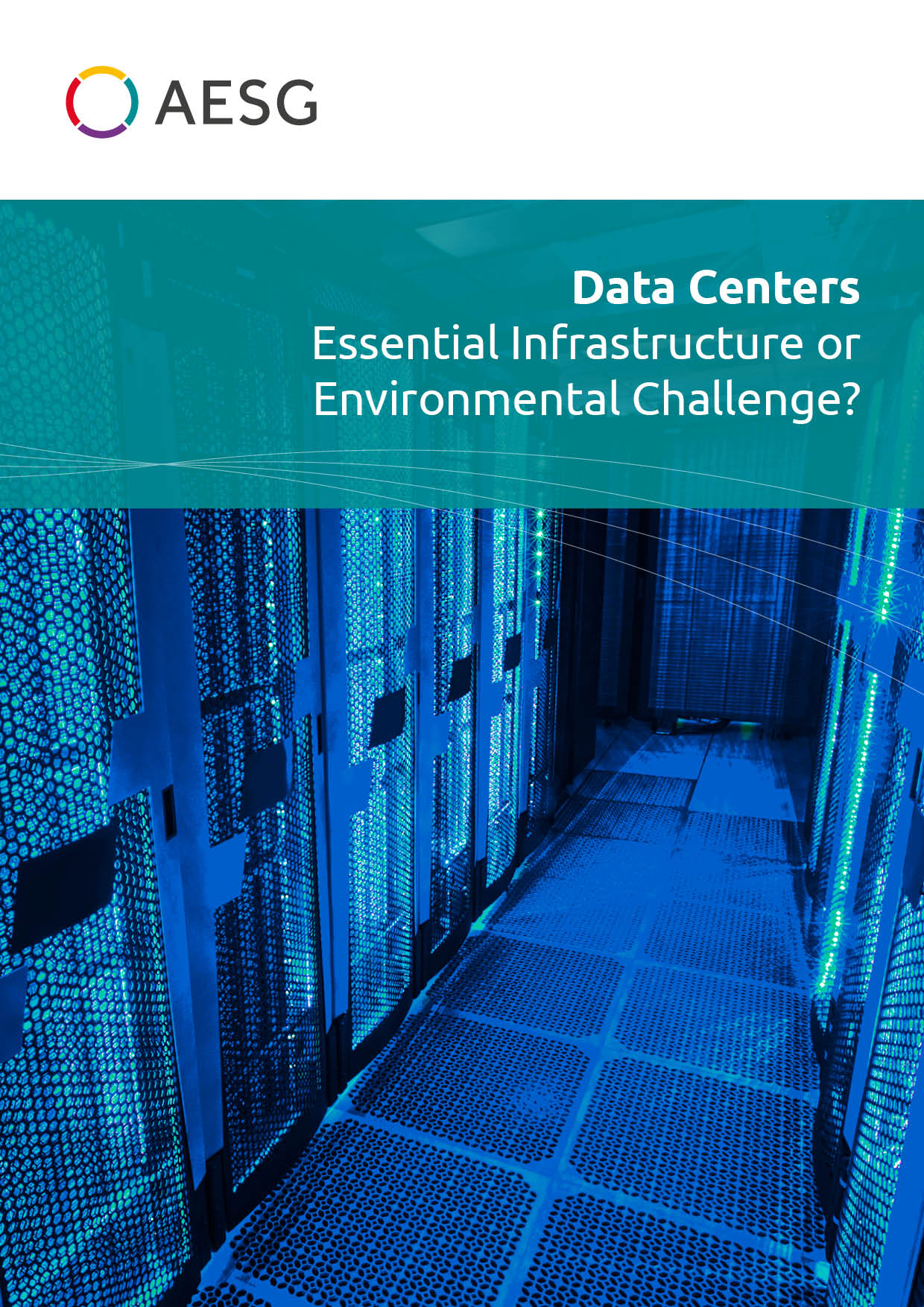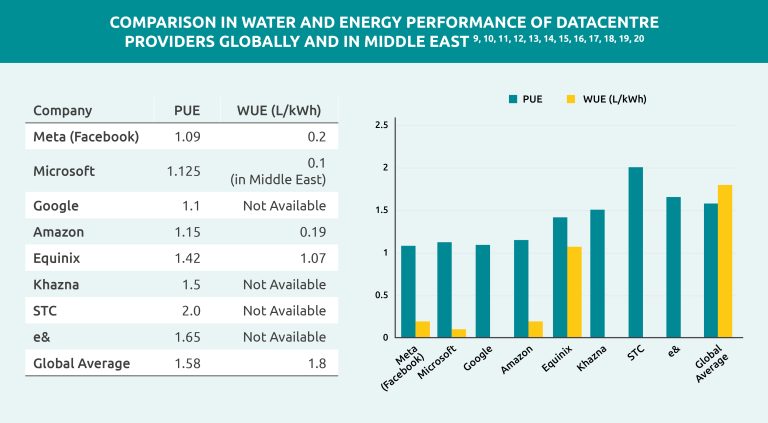
If AI is the industrial revolution of our age, data centers are the engine driving this transformation. While the revolution started in Silicon Valley, the Middle East, particularly the UAE, has been gaining momentum as a hub for data center growth, with expectations to double the market size by 2030. Key factors contributing to this growth include:

Central Geographical Location
Facilitates better connectivity and lower latency.

Government Support
Initiatives and investments from the government bolster infrastructure development.

Data Sovereignty
Increasing demand for local data storage due to regulatory requirements.

Increased Digitalisation
Growing reliance on digital services fuels the need for robust data infrastructure.
The UAE boasts the fastest-growing data center industry in the Middle East, with active projects amounting to US$1.2 billion and a future project pipeline of US$433 million1. In Dubai alone, with 99% of the population already active online, initiatives such as Smart Dubai have accelerated digital transformation, boosting the demand for advanced digital infrastructure. Enablers for this market include robust fibre connectivity, a reliable power grid, and a streamlined construction permit process. Additionally, the UAE remains competitive regarding data center construction costs, ranking 11th globally in 20232.
The UAE data centre industry
active projects
future project pipeline1
Ranked
in competitive data center construction costs in 20232
Expansion of Data Centers in Saudi Arabia
In 2021, Saudi Arabia launched an ambitious USD 18 billion strategy to establish a nationwide network of large-scale data centers1. The Kingdom currently hosts 22 active co-location facilities with over 40 more under construction, primarily concentrated around Riyadh, Jeddah, and Dammam1. Notable giga projects like Neom emphasise the development of reliable infrastructure to position Saudi Arabia as a leading ICT hub. Factors supporting this expansion include:

Strict Data Protection Laws
Enhance trust and compliance for data storage.

Sizeable Domestic Market
Large and growing market demands robust data infrastructure.
Data centers are significant energy consumers, often operating behind the scenes without visible emissions. According to the International Energy Agency (IEA), data centers consumed 460 terawatt-hours of electricity in 20223. To contextualise, this is more than the annual energy usage of Spain. Globally, data centers account for approximately 3% of all electricity usage and up to 1% of all greenhouse gas emissions3. The rapid growth of IoT devices is projected to drive technology industries to account for between 7% to 20% of global energy demands by 20304.
Beyond electricity, data centers require substantial water for cooling systems. A typical small one-megawatt data center using traditional cooling methods consumes over 26 million litres of water annually5, equivalent to filling more than 10 Olympic-sized pools.
Advancements in chip design and faster servers result in significant electronic waste. E-waste is one of the fastest-growing waste streams globally, with annual production expected to reach 75 million metric tons by 20306. While global e-waste holds roughly $60 billion-worth of raw materials such as gold, palladium, silver, and copper, only 17% is documented to be collected and properly recycled each year6.


Energy Consumption
High electricity usage contributes to significant carbon emissions.

Water Usage
Intensive cooling processes lead to massive water consumption.

E-waste
Rapid technological advancements result in increased electronic waste.

Greenhouse Gas Emissions
Data centers contribute up to 0.3% to 1% of global emissions.
Despite the critical role of data centers, sustainability often takes a backseat to uptime, redundancy, and security. However, there is potential for significant environmental improvements without compromising performance.
Leading tech giants like Microsoft, Google, and Facebook have pledged to achieve net-zero goals by 2030. Regional providers too have made ambitious commitments:

Committed to zero carbon emissions (scope 1 and 2) by 20407

Aim for carbon neutrality by 20508

Adiabatic Cooling
Utilises evaporation instead of mechanical air conditioning, reducing electricity use by up to 90% compared to traditional systems21. Depending on local conditions and the availability of reclaimed water, it can be implemented using both indirect evaporative cooling (IDEC) and direct evaporative cooling (DEC). Adiabatic free-cooling chillers were employed in the Khazna Abu Dhabi 6 (AUH 6) data center in Masdar, which achieved LEED Gold and Estidama 4-Pearl certifications.
Liquid Cooling
Liquid cooling is significantly more efficient than air cooling, as liquids can transmit up to 22.4 times more energy than air. This enhanced efficiency has driven the adoption of liquid cooling in recent years, with configurations varying from full immersion of servers to the use of liquid heat exchangers directly mounted on heat-generating equipment. While liquid cooling offers superior performance, especially in high-performance computing environments and data centers with high power density, it requires a higher initial investment compared to traditional air cooling systems. The ideal use case for liquid cooling is in scenarios where air systems are insufficient to meet the cooling demands, ensuring optimal performance and energy efficiency.
Optimised Operating Parameters
Data centers have traditionally maintained strict temperature and humidity controls to ensure the reliability of IT equipment. However, these stringent measures have led to excessive energy consumption. Recent research conducted by Facebook, Intel, The Green Grid, and ASHRAE indicates that higher operating temperatures are not as detrimental to IT equipment as previously believed22. According to the new ASHRAE guidelines, Class A3 devices can safely operate at temperatures up to 104°F (40°C) , provided that these increases remain within the recommended and allowable limits.
While increasing operating temperatures presents benefits, several factors must be considered, including personnel safety, server fan power, and the potential for hot spots. Despite these considerations, the potential energy savings make it a worthwhile strategy. For instance, every 1°F (-17.22°C) increase in server inlet temperature can result in a 4% to 5% reduction in energy costs23.
Reflecting this shift, Equinix announced last year its plan to raise the operating temperature in its data halls to 80°F (26.667°C), which is warmer than the traditional range of 68°F to 72°F (20°C – 22.22°C) 24. This adjustment underscores the industry’s move towards more energy-efficient practices without compromising equipment performance.
Backup Power Alternatives
Given the importance of uptime on profitability, it is no surprise that data center owners continue to rely on tried-and-true technologies like diesel generators as a source of backup power. It is estimated that there are more than 20 gigawatts of backup diesel generators in service globally across the data center industry today25. While some developers have turned to natural gas-fired generators to reduce their carbon footprint, these alternatives remain incompatible with net-zero ambitions. Additionally, natural gas generators do not eliminate NOx (nitrogen oxides NO and NO2) and SOx (sulfur oxide) emissions, and their noise levels are similar to those of diesel generators.
Hydrogen-powered fuel cell generators present a promising alternative for data centers seeking to move away from diesel-based backup power. These fuel cells offer a cleaner and quieter solution, aligning better with sustainability goals. However, the central challenge lies in balancing the use of different power backup technologies:
UPS (Uninterruptible Power Supply
Provides immediate power to critical loads during short-term outages.
BESS (Battery Energy Storage Systems)
Offers mid-duration energy storage and backup power, bridging the gap between immediate and long-term power needs.
Fuel Cells
Serve as a long-term backup power solution, ensuring continuous operation during extended outages.
Achieving an optimal balance among UPS, BESS, and fuel cells is crucial for data centers aiming to eliminate the reliance on diesel generators entirely. This integration will pave the way for a future where backup power is both reliable and sustainable, supporting the industry’s transition towards net-zero emissions.
Commissioning
Technical commissioning plus detailed failure scenario testing are essential for reducing energy consumption and ensuring uptime in any data center. In data centers, it becomes increasingly important to ensure the optimised operation and performance of energy systems. Effective commissioning management throughout the design, construction, and installation phases, as well as ongoing monitoring-based commissioning during operations, ensures that systems continuously perform as required.
Water usage in data centers can be optimised through:
Water Monitoring
The data available on water consumption in data centers is limited, especially when compared to energy usage. Monitoring water consumption—whether for direct usage, cooling, or process applications—is essential for establishing targets, setting benchmarks, and tracking overall consumption. Implementing advanced water metering and monitoring systems enables prompt detection and correction of leakages or inefficiencies, thereby optimising water use and reducing waste.
Alternative Water Sources
Data centers can use numerous water supply sources, including potable water, treated effluent, or reclaimed/recycled water. The quality of the cooling water, however, can affect the equipment’s useful life. Reclaimed water, for example, can cause more corrosion, scaling, and microbiological growth in the equipment than potable water. This depends on the specific properties of the available water supply.
Using its own purpose-built system, a Google data center in Georgia, USA, takes treated effluent from the local water and sewer authority’s treatment plant and further treats the effluent to make it reusable26. Another example from Google is a data center in Hamina, Finland, where seawater was used to cool equipment27.
Effective waste management in data centers includes:
Server Technology
Server infrastructure providers and vendors, such as Intel and Dell, are developing solutions that enable the dynamic composition and decomposition of disaggregated systems. These solutions aim to maximise efficiency and extend the lifespan of server components. Instead of dismantling and replacing entire units, these companies are striving to simply replace the host processing unit (HPU), or “main brain,” thereby reducing power consumption.
Server Reuse
The circular approach to server disposal involves maintaining servers for as long as possible, refurbishing components for future reuse, reusing or reselling components following a rigorous security process, and recycling any components that cannot be reused. Google is at the forefront of this initiative, with 38% of its owned and operated data centers achieving Zero Waste to Landfill. In 2022, Google resold nearly 5 million components, and 21% of the components used for server deployment, maintenance, and upgrades were refurbished inventory28.
Modular Design
Modular design involves constructing data centers using prefabricated standardised modules. This approach offers flexibility, scalability, and efficiency. Different types of modules are available, with the most common being IT, power, and cooling modules. Additionally, modular design can be applied to the building envelope, where prefabricated modules are connected on-site. This method reduces waste during deconstruction, particularly when the connections between modules are reversible. Furthermore, all-in-one modules that combine IT, power, and cooling infrastructure into a single scalable unit are also available.
Building Reuse
Most of the embodied carbon from the construction of a data center is concentrated in the foundation, structure, and envelope. Repurposing vacant buildings into data centers presents an opportunity to reduce this carbon footprint. Successful examples of such conversions can be found around the world, particularly in Hong Kong, where land availability is limited. Warehouses and large retail spaces are ideal for conversion, however, offices can also be considered under certain circumstances. Key considerations when evaluating a building conversion include available power, clear height to accommodate installations, and the structural integrity of the building to support racks, backup power, and cooling systems.
The future of data centers hinges on ongoing technological advancements and evolving regulatory measures aimed at minimising environmental impacts and promoting sustainability. Providers like Intel and Dell are developing solutions for dynamic system composition to maximise efficiency and extend equipment lifespans, while innovations in cooling technologies, such as adiabatic and liquid cooling, are crucial for enhancing energy efficiency. Concurrently, regulatory frameworks must evolve to support sustainable growth by implementing local and regional policies that mandate energy and water efficiency, as well as establishing consistent international standards to harmonise sustainability efforts.
In closing, data centers are essential for powering the digital economy, enabling technologies like AI and IoT. However, they also present significant environmental challenges, including high energy and water consumption and substantial e-waste generation. To address these issues, the industry must adopt innovative cooling technologies, optimise operational parameters, and implement effective waste management practices. Additionally, repurposing existing buildings and enhancing water conservation strategies can further mitigate environmental impacts. Regulatory measures at all levels are crucial to ensure sustainable growth. Balancing the indispensable role of data centers with their environmental responsibilities is essential.
AESG is an international Consultancy, Engineering and Advisory firm committed to driving sustainability in the built environment and beyond. With the highest calibre leadership team in our field, we pair technical knowledge with practical experience to provide hands-on, bespoke strategic solutions to our clients.
We have one of the largest dedicated specialist consultancy teams working on projects within the building, urban planning, infrastructure and strategic advisory sectors. With decades of cumulative experience, our team offers specialist expertise in sustainable design, sustainable engineering, MEPF, fire and life safety, façade engineering, commissioning, digital delivery, waste management, environmental consultancy, strategy and advisory, security consultancy, cost management and acoustics. Our prestigious portfolio demonstrates our extensive capabilities and our ability to consistently deliver best in class solutions to some of the industry’s most complex technical challenges.

Senior Associate Sustainability Consultant, AESG
Sarah Jaber is a Senior Associate Consultant in Sustainability at AESG where she manages the delivery of complex projects in the built environment throughout design and construction and leads on developing sustainability frameworks and guidelines for clients. Sarah has over 13 years of experience working on various projects across the middle east and Europe. Some of her latest projects include developing sustainability guidelines for the design, construction and operations of Dubai Holding assets, leading the circular economy strategy for SEVEN (Saudi Entertainment Ventures) and delivering multiple sustainability strategies for developments in UAE and KSA. Sarah has worked on numerous sustainable projects in the region. She was also a lecturer on sustainable development as part of The Circular Hub.
Sarah holds a MEng in Applied Energy and a BEng of Mechanical Engineering. She is also a LEED Accredited Professional, a BREEAM International Assessor, an Edge expert a Certified Energy Manager. Sarah is also one of the few professionals in the region with a certification in circular economy for the built environment.
For further information relating to specialist consultancy engineering services, feel free to contact us directly via info@aesg.com

ISO 27001:2022
ISO 9001:2015
ISO 14001:2015
ISO 45001:2018
Cayan Business Tower
3rd, 6th & 11th Floor
Barsha Heights
P.O. Box 2556
Dubai, United Arab Emirates
T / +971 (0) 4 432 6242
305 Mermaid House
2 Puddle Dock
London, EC4V 3DS
United Kingdom
T / +44 (0) 208 037 8762
Haibu Space, Abu Dhabi Mall
1st floor, Office 37
Tourist Club Area
Abu Dhabi, United Arab Emirates
T / +971 (0) 2 201 2527
9391 Wadi Al Thummamah
2444 Al Olaya District
PO Box 12214
Riyadh, Kingdom of Saudi Arabia
T / +966 (0) 112 278 288
111 Somerset Road
#08-10A, 111 Somerset
Singapore 238164
11th Floor, Office 1101
2 Long Street
Cape Town 8000
Western Cape, South Africa
T / +27 (0) 21 137 6444
8 Parramatta Square
49th Floor, Office 117
Parramatta, Sydney
New South Wales 2150
Australia
T / +61 (0) 2 8042 6817
Regus Rialto, West Podium
Level Mezzanine 2 (M2)
525 Collins Street
Melbourne, Victoria 3000
Australia
Regus Egypt, East Lane
1st Floor, Office 130
Plot number B-340
New Cairo 1
Cairo Governorate 4740003
Egypt
Cayan Business Tower
3rd, 6th & 11th Floor
Barsha Heights
P.O. Box 2556
Dubai, United Arab Emirates
T / +971 (0) 4 432 6242
305 Mermaid House
2 Puddle Dock
London, EC4V 3DS
United Kingdom
T / +44 (0) 208 037 8762
Office 37, Haibu Space
1st floor, Abu Dhabi Mall
Tourist Club Area
Abu Dhabi, United Arab Emirates
T / +971 (0) 2 201 2500
9391 Wadi Al Thummamah
2444 Al Olaya District
PO Box 12214
Riyadh, Kingdom of Saudi Arabia
T / +966 (0) 112 278 288
111 Somerset Road
#08-10A, 111 Somerset
Singapore 238164
WeWork, 80 Strand St
Cape Town City Centre
Cape Town, 8001
South Africa
T / +27 21 137 6444
49th Floor, Office No.117
8 Parramatta Square
Parramatta, Sydney
New South Wales 2150
Australia
T / +61 (0) 2 8042 6817
Regus Rialto, West Podium
Level Mezzanine 2 (M2)
525 Collins Street
Melbourne, Victoria 3000
Australia
Enawalks, 4th Floor, Office 417
Leaders International College Road
2F97+6VJ New Cairo 1
Cairo Governorate 4724242
Egypt
T / +20 15 01692187